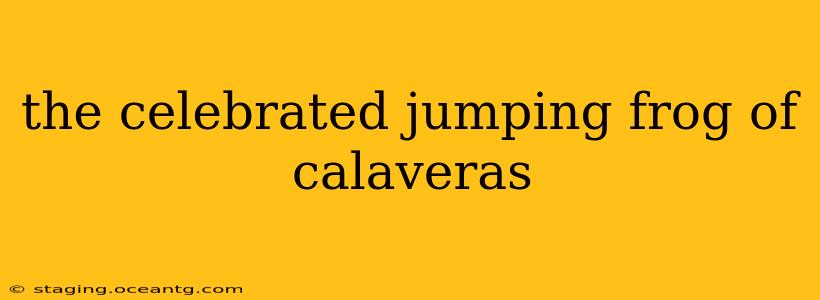Mark Twain's "The Celebrated Jumping Frog of Calaveras County" is more than just a funny story; it's a masterful piece of American literature that transcends its seemingly simple narrative. Published in 1865, this short story cemented Twain's reputation as a gifted humorist and a keen observer of human nature. While the surface-level humor is undeniable, a deeper dive reveals layers of satire, social commentary, and literary innovation. This exploration delves into the story's enduring appeal, examining its themes and lasting impact.
What is the main point of "The Celebrated Jumping Frog of Calaveras County"?
The main point of "The Celebrated Jumping Frog of Calaveras County" isn't easily summarized in a single sentence. Instead, it offers a multifaceted commentary. On one hand, it's a brilliantly executed humorous anecdote, showcasing Twain's talent for creating memorable characters and crafting witty dialogue. However, the story also subtly satirizes the naivete of the narrator and, by extension, the Eastern perspective on the rough-and-tumble West. The seemingly simple tale serves as a vehicle to explore themes of regional differences, storytelling traditions, and the deceptive nature of appearances. Ultimately, the main point hinges on the reader's interpretation, highlighting the story's enduring complexity.
What type of story is "The Celebrated Jumping Frog of Calaveras County"?
"The Celebrated Jumping Frog of Calaveras County" is primarily a frame story or story within a story. The narrative unfolds through a narrator recounting a tale he heard from a local character, Simon Wheeler. This framing device is crucial, as it allows Twain to explore the contrast between the sophisticated Eastern narrator and the more rustic, unrefined Western storyteller. The inner story itself is a humorous tall tale, characterized by exaggeration and hyperbole. This genre choice further contributes to the story's comedic effect and its portrayal of regional differences.
What is the setting of "The Celebrated Jumping Frog of Calaveras County"?
The setting is crucial to the story's success. The story takes place in Calaveras County, California, during the post-Gold Rush era. This specific location is vital because it immediately evokes a sense of the Wild West – a place characterized by its frontier spirit, its unique characters, and its boisterous atmosphere. The rough-and-tumble environment of Calaveras County provides a perfect backdrop for Simon Wheeler's tall tale and enhances the story's humor and authenticity. The setting itself becomes a character in the narrative, shaping the tone and influencing the characters' behavior.
What is the significance of the title "The Celebrated Jumping Frog of Calaveras County"?
The title itself is ironic. While it suggests a grand and exciting story about an extraordinary frog, the actual tale is more about the quirky characters and the storytelling itself. The title sets up an expectation that isn't entirely fulfilled, highlighting the deceptive nature of appearances, a theme that runs throughout the story. Furthermore, the inclusion of "Calaveras County" immediately establishes the story's geographical and cultural context, grounding it within the specific regional identity of the American West.
What are the themes in "The Celebrated Jumping Frog of Calaveras County"?
The story explores several key themes:
- Regionalism: The stark contrast between the sophisticated East Coast narrator and the folksy, unrefined Western storyteller Simon Wheeler is a central theme. Twain highlights the differences in language, culture, and storytelling traditions between the two regions.
- Deception and Appearances: The story is full of ironic twists and turns, reminding the reader that things aren't always what they seem. The seemingly simple tale of a jumping frog is actually a vehicle for exposing the deceptive nature of appearances and the manipulation of storytelling.
- The Nature of Storytelling: The story is as much about the act of storytelling itself as it is about the story being told. Twain masterfully uses the frame narrative to explore the art of storytelling, emphasizing the role of the storyteller in shaping the narrative and the listener's perception.
- Humor and Satire: Twain's use of humor, particularly through exaggeration and hyperbole, is a key element of the story. However, this humor also serves a satirical purpose, poking fun at naivete, pretentiousness, and the clash of cultures.
"The Celebrated Jumping Frog of Calaveras County" remains a timeless classic precisely because it transcends its initial humorous premise. By employing masterful storytelling techniques and exploring complex themes, Mark Twain created a work that continues to resonate with readers today, a testament to its literary significance.
